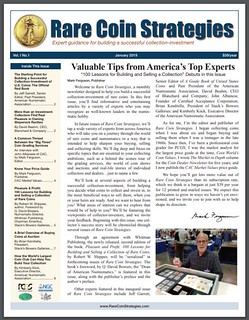
PREV ARTICLE
NEXT ARTICLE
FULL ISSUE
PREV FULL ISSUE
INTERVIEW: COIN GRADING MOGUL JOHN ALBANESEIn the inaugural January 2019 issue of his Rare Coin Strategies newsletter, publisher Mark Ferguson interviewed John Albanese, a founder or founding member of all three of the major U.S.-based coin grading services. With permission, here's an excerpt from the article's introduction. -Editor
The concept caught on and in 1987 Numismatic Guaranty Corporation (NGC) was launched. Numerous copy-cat coin grading services also sprang up, but PCGS and NGC have dominated the market since their beginnings. The dominance of these two coin grading services is so widespread that even though the grading standards of other firms may be perfectly acceptable to most experienced numismatists, the vast majority of coin buyers prefer only coins graded by PCGS or NGC. Two decades later, in 2007, a new service was launched: Certified Acceptance Corporation (CAC). Its purpose was different from those of PCGS and NGC. Because coins graded the same vary in condition from barely making a grade to nearly reaching the next grade, CAC was developed to identify and separate solid-for-the-grade and premium-quality coins from those that barely make a grade. CAC only reviews coins that have already been graded and encapsulated by PCGS and NGC. For those coins that meet CAC’s strict standards, a tamper-resistant, oval, green, CAC logo-sticker is placed on the PCGS and NGC holders of the coins it approves. This sticker has come to be known as a “green bean.” While CAC is not in the business of valuing the coins it approves, CAC has had a noteworthy bearing on the market values of the coins it approves. Wide-ranging data shows that most CAC-stickered coins sell for premium prices over like-kind coins, graded the same, that have not earned a coveted green bean. CAC coins also tend to sell more quickly than those that do not possess CAC stickers. So, it is with this background that I interviewed John Albanese, the one individual who is like a common thread woven between the “Big Three” coin grading services: PCGS, NGC and CAC. John was part of the original group of about a half dozen coin dealers who founded PCGS in 1986; he formed NGC the following year, then sold it in late 1998; and he currently operates CAC, which he founded in 2007. For more information on Rare Coin Strategies, or to subscribe, see: 
Wayne Homren, Editor The Numismatic Bibliomania Society is a non-profit organization promoting numismatic literature. See our web site at coinbooks.org. To submit items for publication in The E-Sylum, write to the Editor at this address: whomren@gmail.com To subscribe go to: https://my.binhost.com/lists/listinfo/esylum All Rights Reserved. NBS Home Page Contact the NBS webmaster 
|
